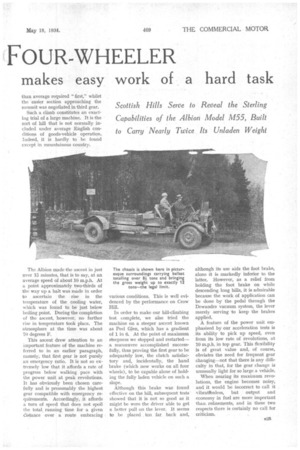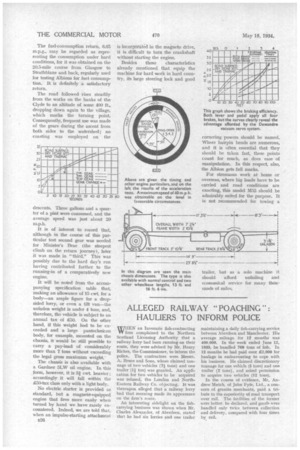MAXIMUM-LOAD FOUR-WHEELER
Page 34

Page 35

Page 36

If you've noticed an error in this article please click here to report it so we can fix it.
makes easy work of a hard task
RUGGED, like the country in which it is built, the Albion M55 goods chassis, introduced last November at the Commercial Motor Show, which can legally carry a gross load of 81 tons, is, generally speaking, simple, orthodox and with out "-frills," but essentially sturdy in spite of its low weight.
It has an 80 b.h.p. four-cylindered engine that, whilst not possessing the silent, smooth running of its sixcylindered counterpart, seems to revel in hard work, and a set of gear Among the noteworthy features of the 6-litre power unit, shown in this illustration, are the accessible transversely mounted magneto, the large oil filler and the hot-spot manifold.
ratios that equip it for economic performance—which implies the maintenance of the highest practicable speeds—under all road conditions. There are no apparent signs of weight cutting and nothing to suggest that its durability—a quality inseparably associated with the Albion name—has been in the least impaired.
One of our most interesting tests consisted of an ascent of Crow Hill, on the road from Lennoxtown to Fintry, which crosses the Campsie Fells by a pass some 1,300 ft. above .aa. level. This road rises approximately 1,100 ft. in 2.7 miles, for which distance it rises steadily. The major part was accomplished in second gear, several stretches steeper than average required "first" whilst the easier section approaching the summit was negotiated in third gear.
Such a climb constitutes an exacting trial of a large machine. It is the sort of hill that is not normally included under average English conditions of goods-vehicle operation. Indeed, it is hardly to be found except in mountainous country.
The Albion made the ascent in just over 15 minutes, that is to say, at an average speed of about 10 m.p.h. At a point approximately two-thirds of the way up a halt was made in order to ascertain the rise in the temperature of the cooling Ivater, which was found to be just below boiling point. During the completion of the ascent, however, no further rise in temperature took place. The atmosphere at the time was about 70 degrees F.
This ascent drew attention to an important feature of the machine referred to in an earlier paragraph, namely, that first gear is not purely an emergency ratio. It is not so extremely low that it affords a rate of progress below walking pace with the power unit at peak revolutions. It has obviously been chosen carefully and is presumably the highest gear compatible with emergency requirements. Accordingly, it affords a turn of speed that does not spoil the total. running time for a given distance over a route embracing
various conditions. This is well evidenced by the performance on Crow Hill.
In order to make our hill-climbing test complete, we also tried the machine on a steeper ascent known as Peel Glen, which has a gradient of 1 in 6. At the point of maximum steepness we stopped and restarted— a rnanceuvre accomplished successfully, thus proving the first gear to be adequately low, the clutch satisfactory and, incidentally, the hand brake (which now works on all four wheels), to be capable alone of holding the fully laden vehicle on such a slope.
Although this brake was found effective on the hill, subsequent tests showed that it is not so good as it might be were the driver able to get a better pull on the lever. It seems to be placed . too far back and, although its use aids the foot brake, alone it is markedly inferior to the latter. However, as a relief from holding the foot brake on while descending long hills, it is admirable because the work of application can be done by the pedal through the Dewandre vacuum system, the lever merely serving to keep the brakes applied.
A feature of the power unit emphasized by our acceleration tests is its ability to pick up speed, even from its low rate of revolutions, at 10 m.p.h. in top gear. This flexibility is of great value and, of course, obviates the need for frequent gear changing—not that there is any difficulty in that, for the gear change is unusually light for so large a vehicle.
When nearing its maximum revolutions, the engine becomes noisy, and it would be incorrect to call it vibratlbnless, but output and economy in fuel are more important than, refinements, and in these two respects there is certainly no call for
criticism.
The fuel-consumption return, 6.65 m.p.g., may be regarded as representing the consumption under hard conditions, for it was obtained on the 20.5-mile course from Glasgow to Strathblane and back, regularly used for testing Albions for fuel consumption. It is definitely a satisfactory return.
The road followed rises steadily from the works on the banks of the Clyde to an altitude of some 400 ft., dropping down again to the village, which marks the turning point. Consequently, frequent use was made of the gears during the ascent from both sides to the watershed; no coasting was employed on the
descents. Three gallons and a quarter of a pint were consumed, and the average speed was just about 20 m.p.h.
It is of interest to record that, although in the course of this particular test second gear was needed for Minister's Brae (the steepest climb on the return journey), later it was made in "third." This was possibly due to the hard day's rim having contributed further to the running-in of a comparatively new engine.
It will be noted from the accompanying specification table that, making an allowance of 15 cwt. for a body—an ample figure for a dropsided lorry, or even a tilt van—the unladen weight is under 4 tons, and, therefore, the vehicle ihi subject to an annual tax of £50. On the other hand, if this weight had to be exceeded and a large pantechnicon body, for example, mounted on the chassis, it would be still possible to carry a pay-load of considerably more than 7 tons without exceeding the legal gross maximum weight: The chaasis is also available with a Gardner 5LW oil engine. In this form, however, it is n cwt. heavier ; accordingly it will fall within the
.50-tax class only with a light body.
No electric starter is provided as standard, but a magneto-equipped engine that fires more easily when turned by hand we have rarely encountered. Indeed, we are told that, when an impulse-starting attachment B26 is incorporated in the magneto drive, it is difficult to turn the crankshaft without starting the engine.
Besides those characteristics already mentioned that equip the machine for hard work in hard country, its large steering lock and good
cornering powers should be named. Where hairpin bends are numerous, and it is often essential that they should be taken fast, these points count for much, as does ease of manipulation. In this respect, also, the Albion gets full marks.
For strenuous work at home or overseas, where big loads have to be carried and road conditions are exacting, this model M:15 should be admirably suited for the purpose. It is not recommended for towing a
trailer, but as a solo machine it should afford unfailing and economical service for many thousands of miles.




















































































